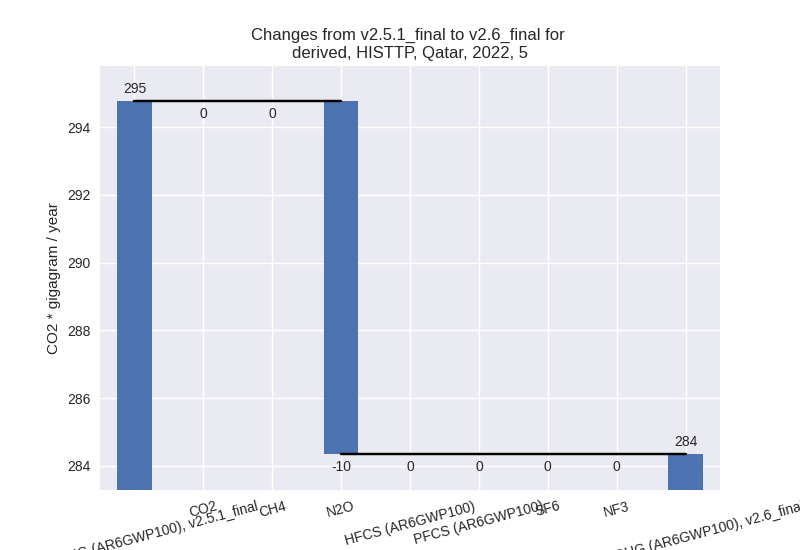Changes in PRIMAP-hist v2.6_final compared to v2.5.1_final for Qatar
2024-09-24
Johannes Gütschow
Change analysis for Qatar for PRIMAP-hist v2.6_final compared to v2.5.1_final
Overview over emissions by sector and gas
The following figures show the aggregate national total emissions excluding LULUCF AR6GWP100 for the country reported priority scenario. The dotted linesshow the v2.5.1_final data.
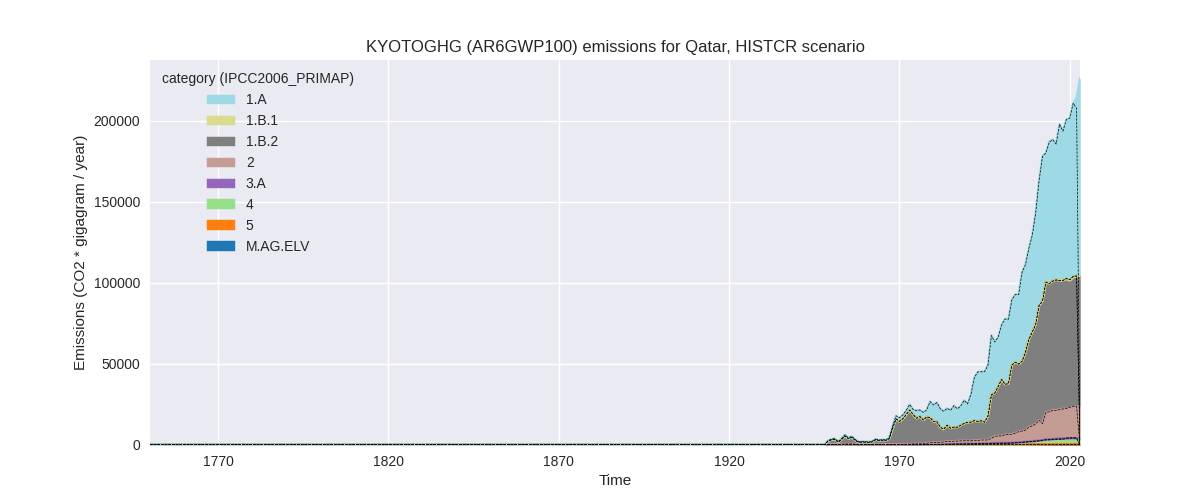
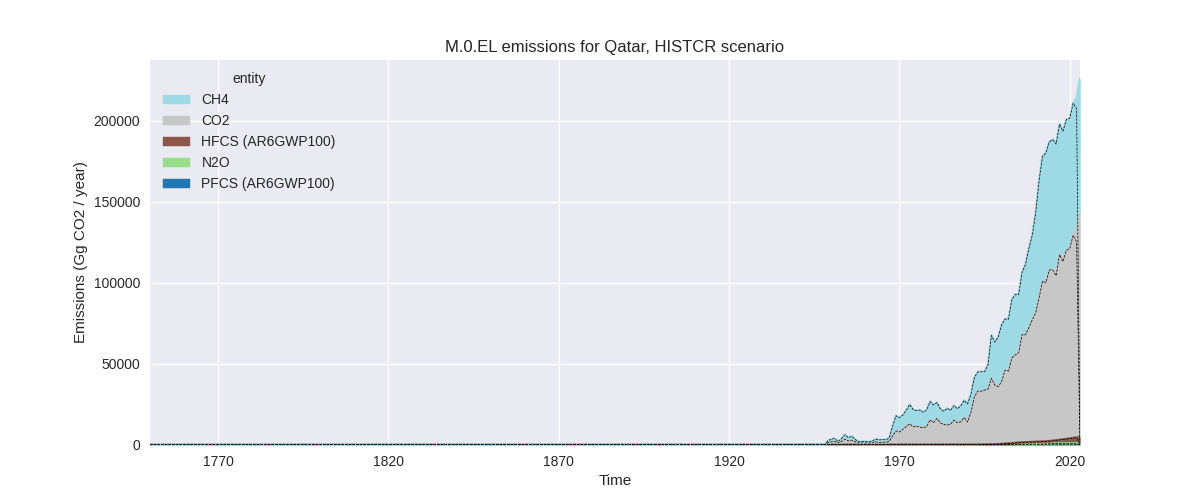
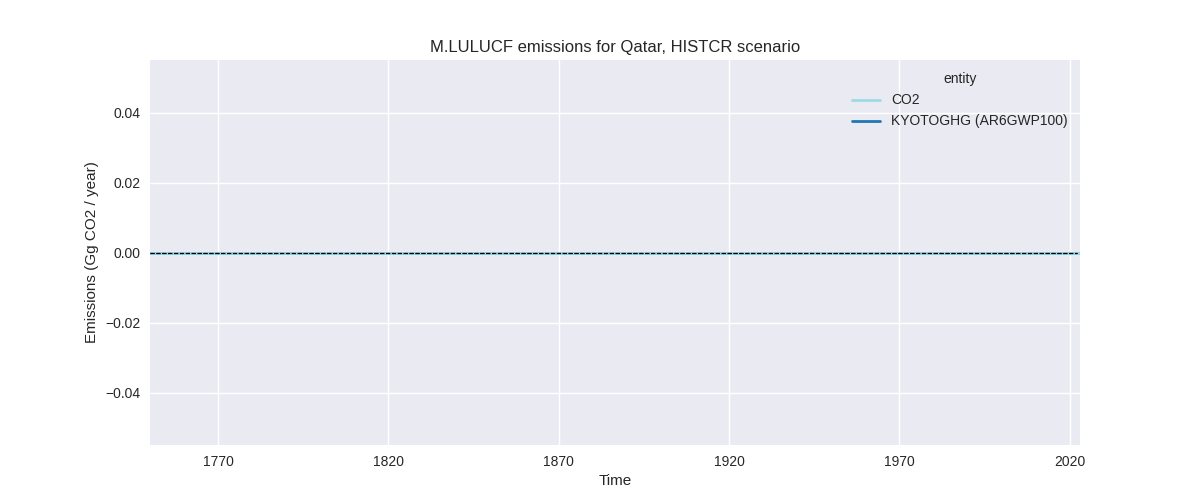
The following figures show the aggregate national total emissions excluding LULUCF AR6GWP100 for the third party priority scenario. The dotted linesshow the v2.5.1_final data.
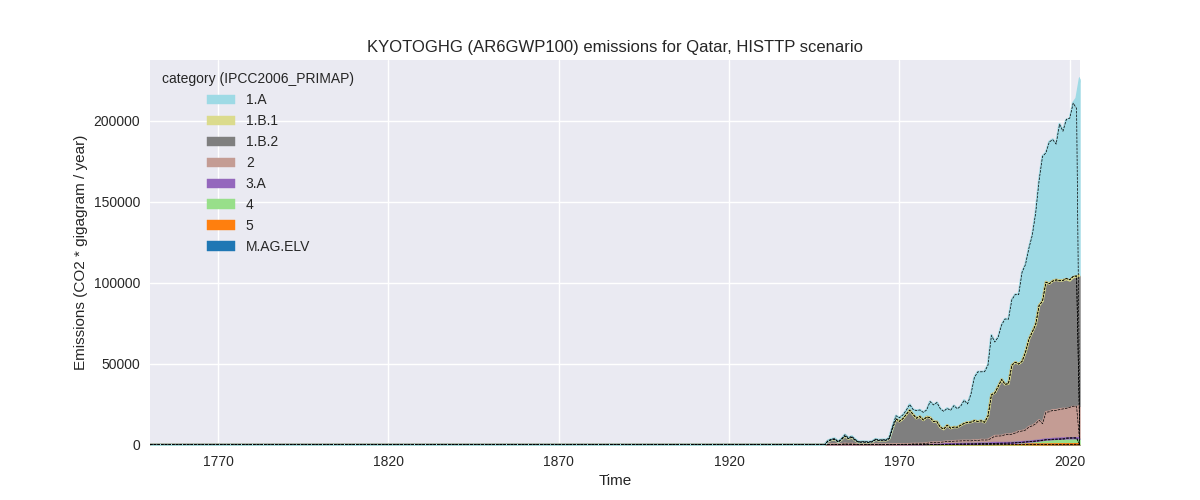
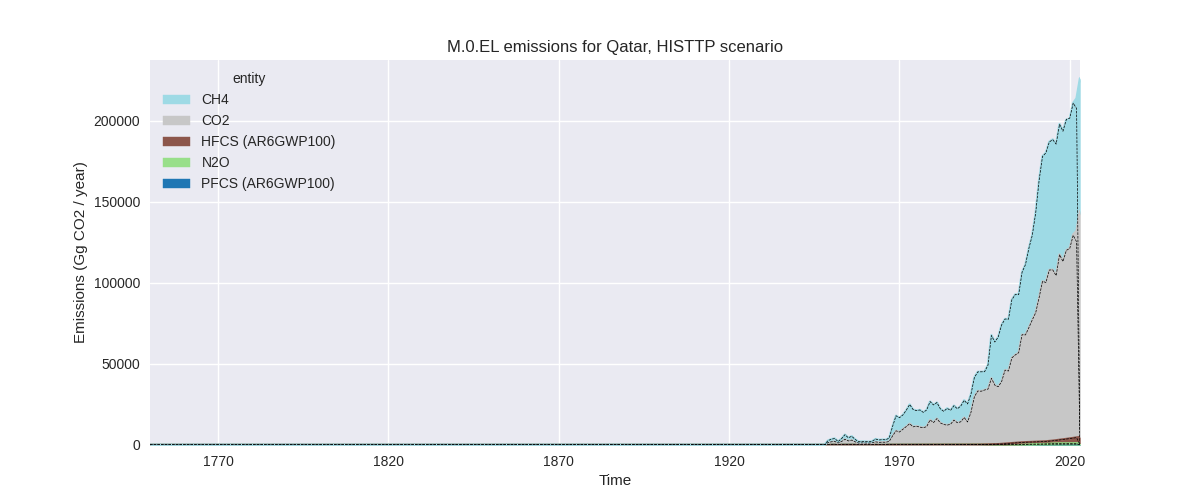
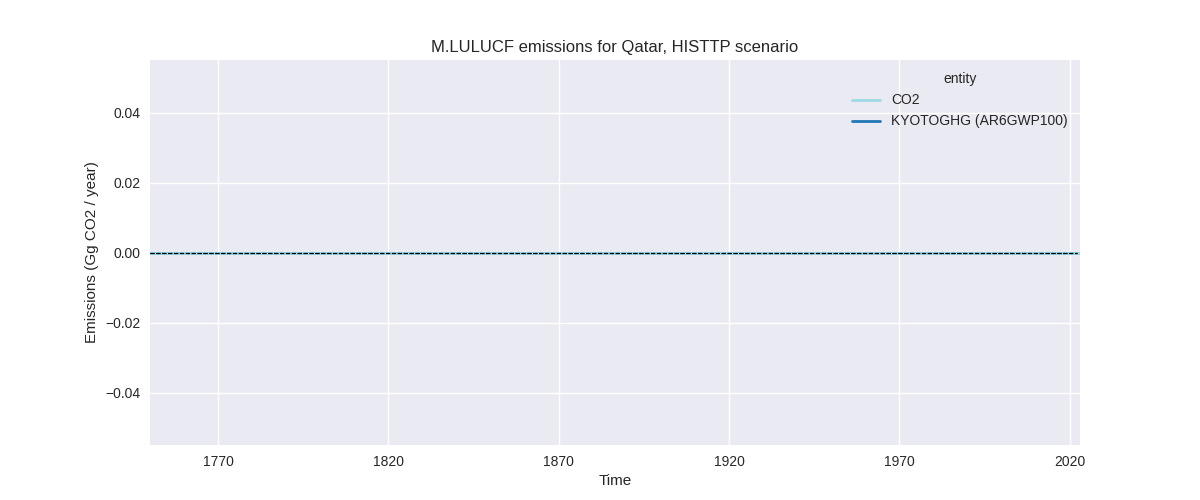
Overview over changes
In the country reported priority scenario we have the following changes for aggregate Kyoto GHG and national total emissions excluding LULUCF (M.0.EL):
- Emissions in 2022 have changed by 3.0%% (6274.95 Gg CO2 / year)
- Emissions in 1990-2022 have changed by 0.2%% (199.40 Gg CO2 / year)
In the third party priority scenario we have the following changes for aggregate Kyoto GHG and national total emissions excluding LULUCF (M.0.EL):
- Emissions in 2022 have changed by 3.0%% (6274.95 Gg CO2 / year)
- Emissions in 1990-2022 have changed by 0.2%% (199.40 Gg CO2 / year)
Most important changes per scenario and time frame
In the country reported priority scenario the following sector-gas combinations have the highest absolute impact on national total KyotoGHG (AR6GWP100) emissions in 2022 (top 5):
- 1: 1.A, CO2 with 6593.77 Gg CO2 / year (6.4%)
- 2: 4, CH4 with -412.10 Gg CO2 / year (-11.5%)
- 3: 2, HFCS (AR6GWP100) with 51.83 Gg CO2 / year (1.5%)
- 4: 4, N2O with 30.18 Gg CO2 / year (84.5%)
- 5: 1.B.2, CO2 with 20.09 Gg CO2 / year (0.8%)
In the country reported priority scenario the following sector-gas combinations have the highest absolute impact on national total KyotoGHG (AR6GWP100) emissions in 1990-2022 (top 5):
- 1: 1.A, CO2 with 213.86 Gg CO2 / year (0.4%)
- 2: 4, CH4 with -20.70 Gg CO2 / year (-1.2%)
- 3: 4, N2O with 11.46 Gg CO2 / year (74.8%)
- 4: 1.B.2, CO2 with -6.11 Gg CO2 / year (-0.2%)
- 5: 2, HFCS (AR6GWP100) with 1.57 Gg CO2 / year (0.1%)
In the third party priority scenario the following sector-gas combinations have the highest absolute impact on national total KyotoGHG (AR6GWP100) emissions in 2022 (top 5):
- 1: 1.A, CO2 with 6593.77 Gg CO2 / year (6.4%)
- 2: 4, CH4 with -412.10 Gg CO2 / year (-11.5%)
- 3: 2, HFCS (AR6GWP100) with 51.83 Gg CO2 / year (1.5%)
- 4: 4, N2O with 30.18 Gg CO2 / year (84.5%)
- 5: 1.B.2, CO2 with 20.09 Gg CO2 / year (0.8%)
In the third party priority scenario the following sector-gas combinations have the highest absolute impact on national total KyotoGHG (AR6GWP100) emissions in 1990-2022 (top 5):
- 1: 1.A, CO2 with 213.86 Gg CO2 / year (0.4%)
- 2: 4, CH4 with -20.70 Gg CO2 / year (-1.2%)
- 3: 4, N2O with 11.46 Gg CO2 / year (74.8%)
- 4: 1.B.2, CO2 with -6.11 Gg CO2 / year (-0.2%)
- 5: 2, HFCS (AR6GWP100) with 1.57 Gg CO2 / year (0.1%)
Notes on data changes
Here we list notes explaining important emissions changes for the country. ’' means that the following text only applies to the TP time series, while means that it only applies to the CR scenario. Otherwise the note applies to both scenarios.
- Changes in 1.A and 1.B.2 for 2021 and 2022 from updated EI data.
- Changes in sectors 4 and 5 are due to the removal of FAOSTAT data.
- As we have no usable country reported data CR and TP time-series are identical.
Changes by sector and gas
For each scenario and time frame the changes are displayed for all individual sectors and all individual gases. In the sector plot we use aggregate Kyoto GHGs in AR6GWP100. In the gas plot we usenational total emissions without LULUCF. ## country reported scenario
2022
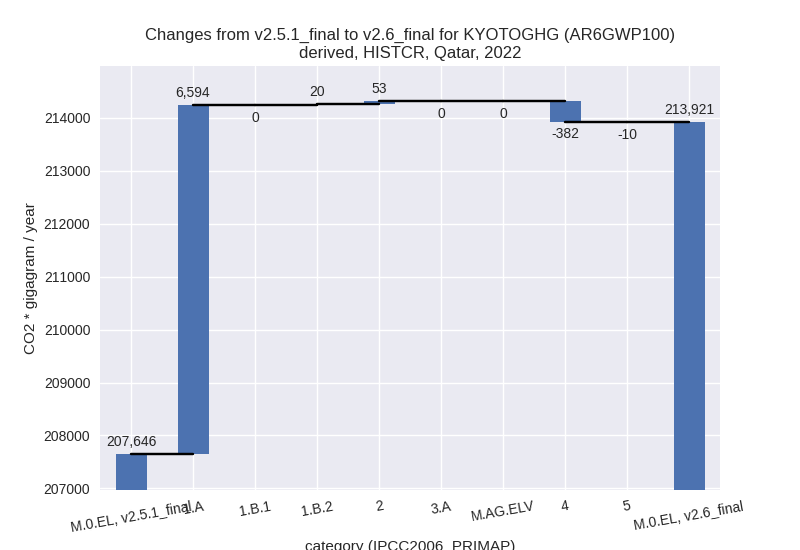

1990-2022
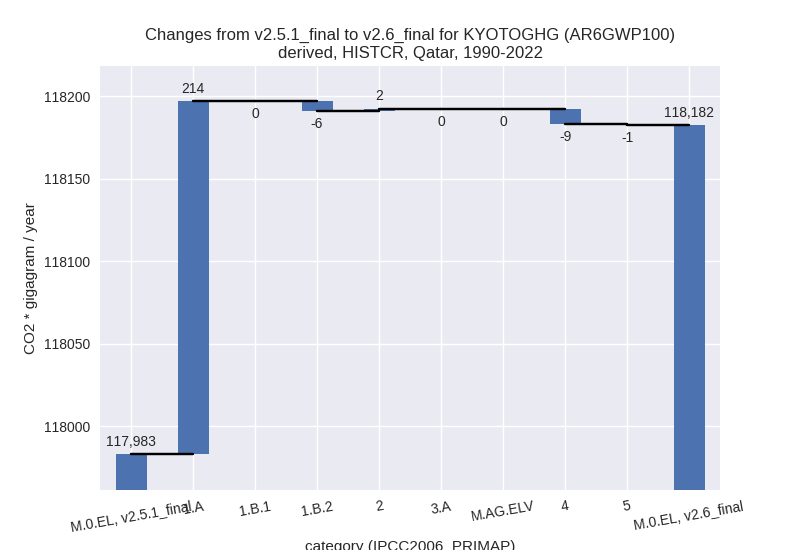

third party scenario
2022
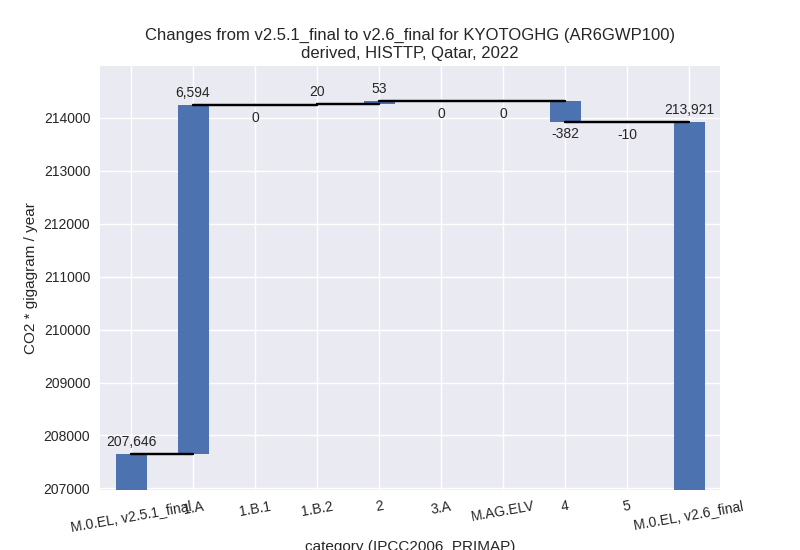
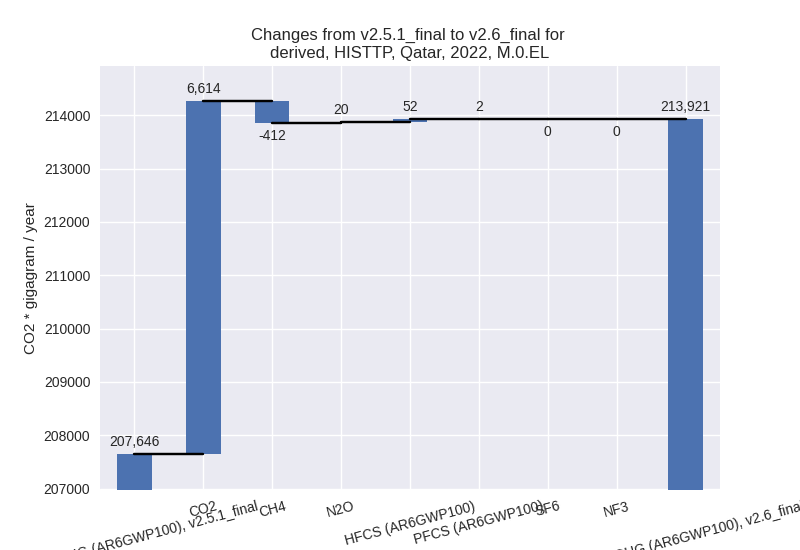
1990-2022
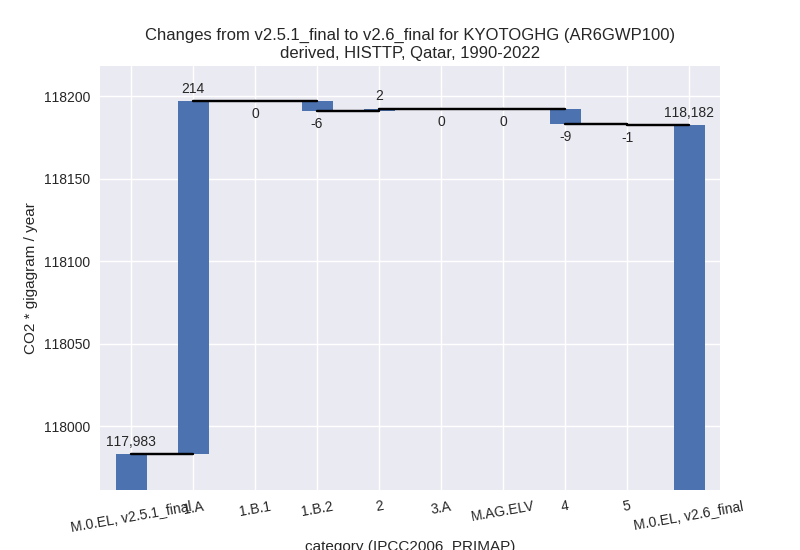
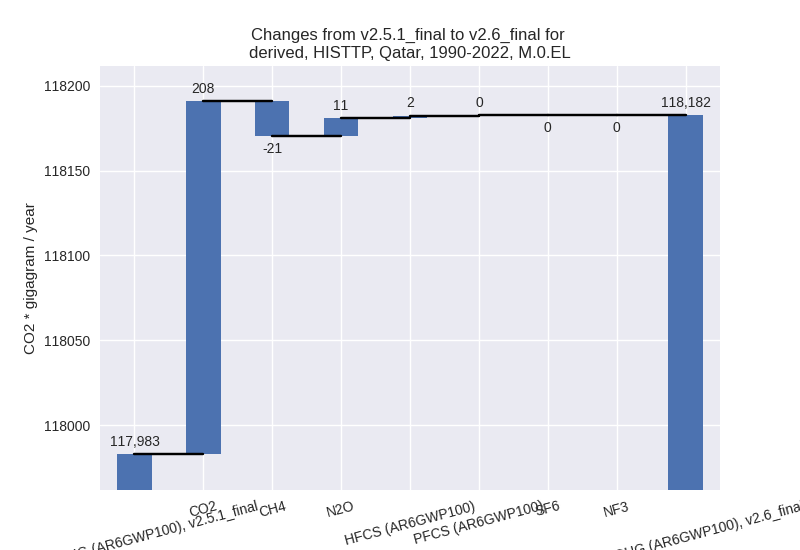
Detailed changes for the scenarios:
country reported scenario (HISTCR):
Most important changes per time frame
For 2022 the following sector-gas combinations have the highest absolute impact on national total KyotoGHG (AR6GWP100) emissions in 2022 (top 5):
- 1: 1.A, CO2 with 6593.77 Gg CO2 / year (6.4%)
- 2: 4, CH4 with -412.10 Gg CO2 / year (-11.5%)
- 3: 2, HFCS (AR6GWP100) with 51.83 Gg CO2 / year (1.5%)
- 4: 4, N2O with 30.18 Gg CO2 / year (84.5%)
- 5: 1.B.2, CO2 with 20.09 Gg CO2 / year (0.8%)
For 1990-2022 the following sector-gas combinations have the highest absolute impact on national total KyotoGHG (AR6GWP100) emissions in 1990-2022 (top 5):
- 1: 1.A, CO2 with 213.86 Gg CO2 / year (0.4%)
- 2: 4, CH4 with -20.70 Gg CO2 / year (-1.2%)
- 3: 4, N2O with 11.46 Gg CO2 / year (74.8%)
- 4: 1.B.2, CO2 with -6.11 Gg CO2 / year (-0.2%)
- 5: 2, HFCS (AR6GWP100) with 1.57 Gg CO2 / year (0.1%)
Changes in the main sectors for aggregate KyotoGHG (AR6GWP100) are
- 1: Total sectoral emissions in 2022 are 190584.30
Gg CO2 / year which is 89.1% of M.0.EL emissions. 2022 Emissions have
changed by 3.6% (6613.85 Gg CO2 /
year). 1990-2022 Emissions have changed by 0.2% (207.75 Gg CO2 / year). For 2022 the
changes per gas
are:
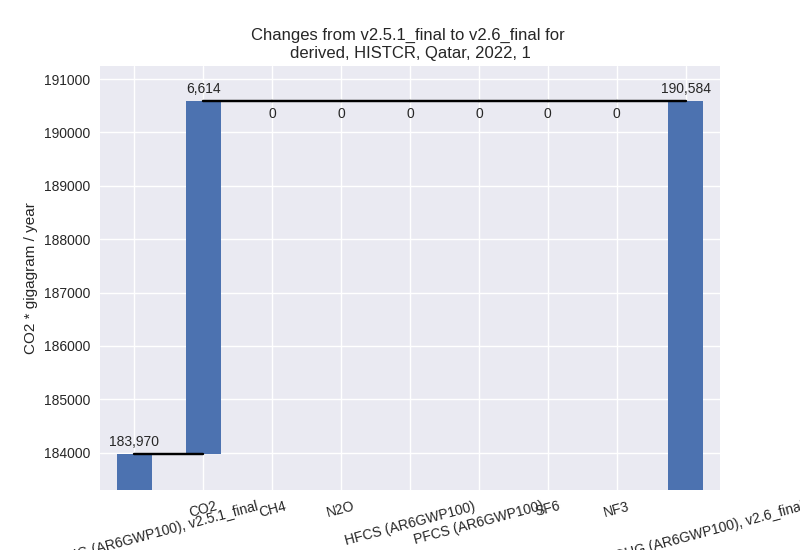
The changes come from the following subsectors:- 1.A: Total sectoral emissions in 2022 are 109931.21
Gg CO2 / year which is 57.7% of category 1 emissions. 2022 Emissions
have changed by 6.4% (6593.76 Gg CO2
/ year). 1990-2022 Emissions have changed by 0.4% (213.86 Gg CO2 / year). For 2022 the
changes per gas
are:
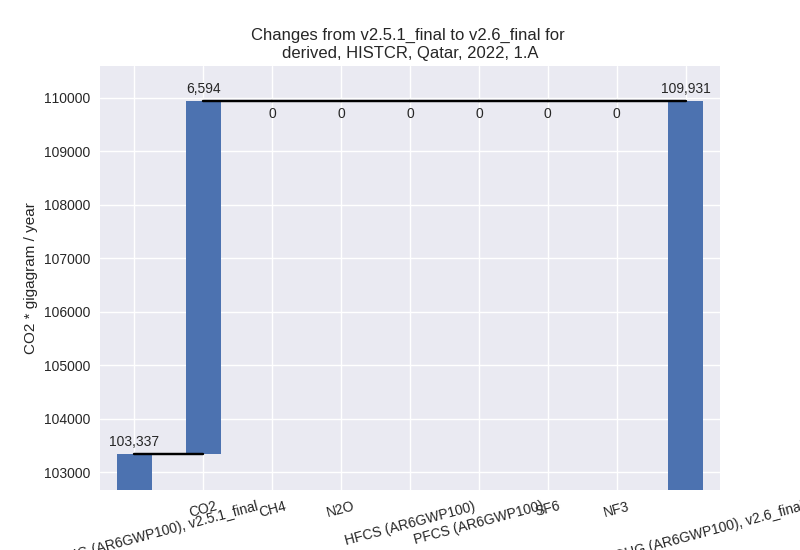
There is no subsector information available in PRIMAP-hist. - 1.B.1: Total sectoral emissions in 2022 are 2.10 Gg CO2 / year which is 0.0% of category 1 emissions. 2022 Emissions have changed by 0.0% (0.00 Gg CO2 / year). 1990-2022 Emissions have changed by 0.0% (0.00 Gg CO2 / year).
- 1.B.2: Total sectoral emissions in 2022 are 80650.99 Gg CO2 / year which is 42.3% of category 1 emissions. 2022 Emissions have changed by 0.0% (20.09 Gg CO2 / year). 1990-2022 Emissions have changed by -0.0% (-6.11 Gg CO2 / year).
- 1.A: Total sectoral emissions in 2022 are 109931.21
Gg CO2 / year which is 57.7% of category 1 emissions. 2022 Emissions
have changed by 6.4% (6593.76 Gg CO2
/ year). 1990-2022 Emissions have changed by 0.4% (213.86 Gg CO2 / year). For 2022 the
changes per gas
are:
- 2: Total sectoral emissions in 2022 are 19188.08 Gg CO2 / year which is 9.0% of M.0.EL emissions. 2022 Emissions have changed by 0.3% (53.44 Gg CO2 / year). 1990-2022 Emissions have changed by 0.0% (1.62 Gg CO2 / year).
- M.AG: Total sectoral emissions in 2022 are 631.72 Gg CO2 / year which is 0.3% of M.0.EL emissions. 2022 Emissions have changed by 0.0% (0.00 Gg CO2 / year). 1990-2022 Emissions have changed by 0.0% (0.00 Gg CO2 / year).
- 4: Total sectoral emissions in 2022 are 3232.78 Gg
CO2 / year which is 1.5% of M.0.EL emissions. 2022 Emissions have
changed by -10.6% (-381.92 Gg CO2 /
year). 1990-2022 Emissions have changed by -0.5% (-9.24 Gg CO2 / year). For 2022 the
changes per gas
are:
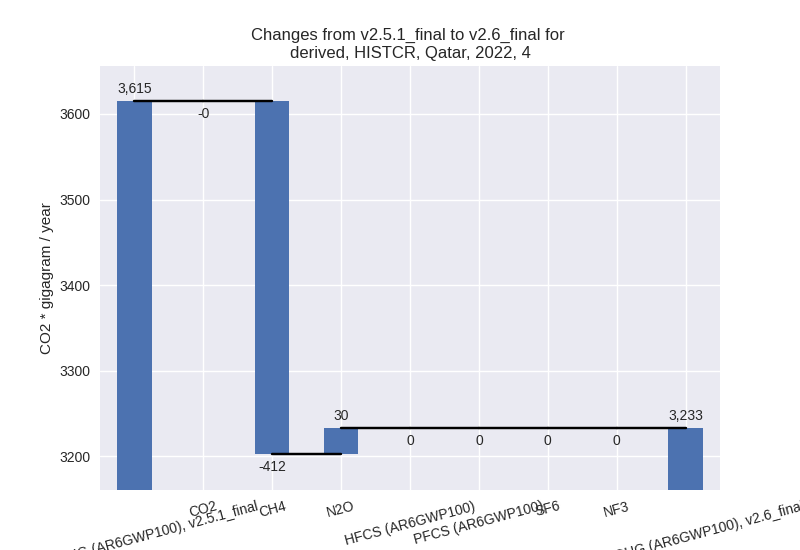
- 5: Total sectoral emissions in 2022 are 284.34 Gg
CO2 / year which is 0.1% of M.0.EL emissions. 2022 Emissions have
changed by -3.5% (-10.42 Gg CO2 /
year). 1990-2022 Emissions have changed by -0.5% (-0.73 Gg CO2 / year). For 2022 the
changes per gas
are:
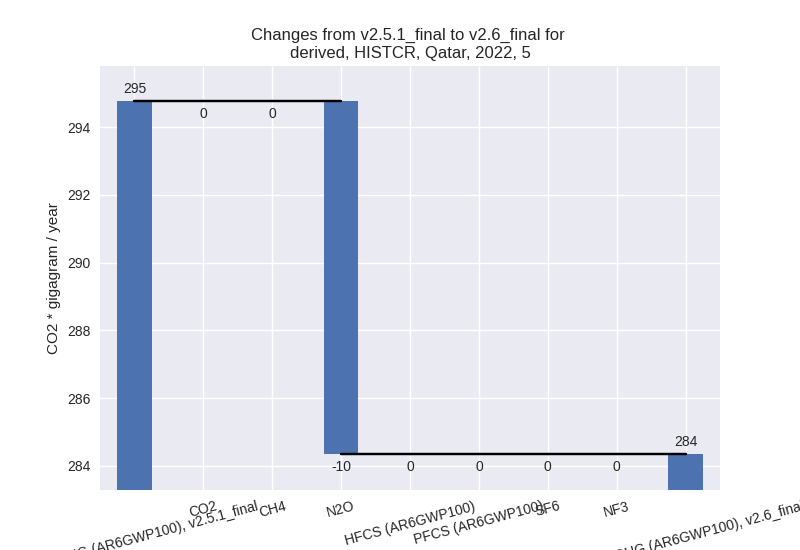
third party scenario (HISTTP):
Most important changes per time frame
For 2022 the following sector-gas combinations have the highest absolute impact on national total KyotoGHG (AR6GWP100) emissions in 2022 (top 5):
- 1: 1.A, CO2 with 6593.77 Gg CO2 / year (6.4%)
- 2: 4, CH4 with -412.10 Gg CO2 / year (-11.5%)
- 3: 2, HFCS (AR6GWP100) with 51.83 Gg CO2 / year (1.5%)
- 4: 4, N2O with 30.18 Gg CO2 / year (84.5%)
- 5: 1.B.2, CO2 with 20.09 Gg CO2 / year (0.8%)
For 1990-2022 the following sector-gas combinations have the highest absolute impact on national total KyotoGHG (AR6GWP100) emissions in 1990-2022 (top 5):
- 1: 1.A, CO2 with 213.86 Gg CO2 / year (0.4%)
- 2: 4, CH4 with -20.70 Gg CO2 / year (-1.2%)
- 3: 4, N2O with 11.46 Gg CO2 / year (74.8%)
- 4: 1.B.2, CO2 with -6.11 Gg CO2 / year (-0.2%)
- 5: 2, HFCS (AR6GWP100) with 1.57 Gg CO2 / year (0.1%)
Changes in the main sectors for aggregate KyotoGHG (AR6GWP100) are
- 1: Total sectoral emissions in 2022 are 190584.30
Gg CO2 / year which is 89.1% of M.0.EL emissions. 2022 Emissions have
changed by 3.6% (6613.85 Gg CO2 /
year). 1990-2022 Emissions have changed by 0.2% (207.75 Gg CO2 / year). For 2022 the
changes per gas
are:
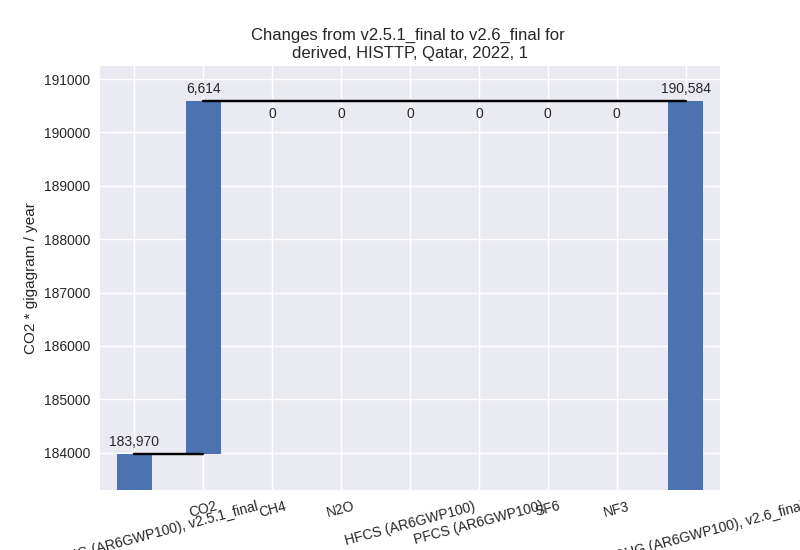
The changes come from the following subsectors:- 1.A: Total sectoral emissions in 2022 are 109931.21
Gg CO2 / year which is 57.7% of category 1 emissions. 2022 Emissions
have changed by 6.4% (6593.76 Gg CO2
/ year). 1990-2022 Emissions have changed by 0.4% (213.86 Gg CO2 / year). For 2022 the
changes per gas
are:
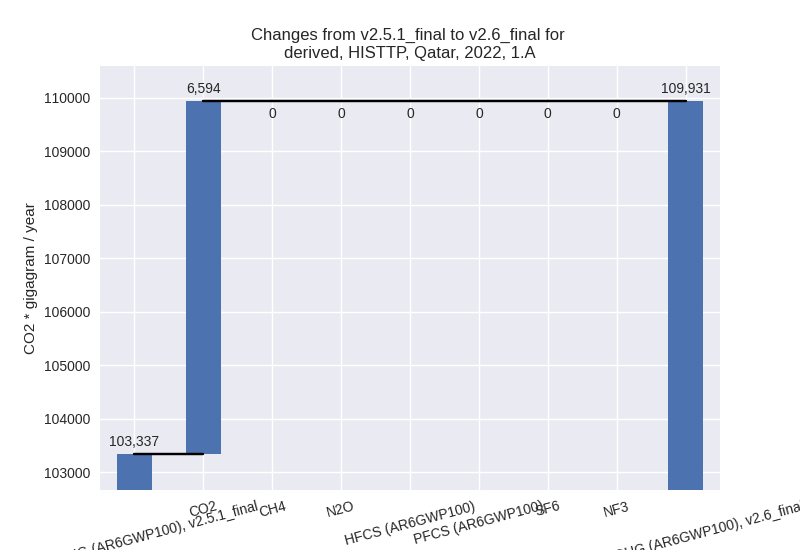
There is no subsector information available in PRIMAP-hist. - 1.B.1: Total sectoral emissions in 2022 are 2.10 Gg CO2 / year which is 0.0% of category 1 emissions. 2022 Emissions have changed by 0.0% (0.00 Gg CO2 / year). 1990-2022 Emissions have changed by 0.0% (0.00 Gg CO2 / year).
- 1.B.2: Total sectoral emissions in 2022 are 80650.99 Gg CO2 / year which is 42.3% of category 1 emissions. 2022 Emissions have changed by 0.0% (20.09 Gg CO2 / year). 1990-2022 Emissions have changed by -0.0% (-6.11 Gg CO2 / year).
- 1.A: Total sectoral emissions in 2022 are 109931.21
Gg CO2 / year which is 57.7% of category 1 emissions. 2022 Emissions
have changed by 6.4% (6593.76 Gg CO2
/ year). 1990-2022 Emissions have changed by 0.4% (213.86 Gg CO2 / year). For 2022 the
changes per gas
are:
- 2: Total sectoral emissions in 2022 are 19188.08 Gg CO2 / year which is 9.0% of M.0.EL emissions. 2022 Emissions have changed by 0.3% (53.44 Gg CO2 / year). 1990-2022 Emissions have changed by 0.0% (1.62 Gg CO2 / year).
- M.AG: Total sectoral emissions in 2022 are 631.72 Gg CO2 / year which is 0.3% of M.0.EL emissions. 2022 Emissions have changed by 0.0% (0.00 Gg CO2 / year). 1990-2022 Emissions have changed by 0.0% (0.00 Gg CO2 / year).
- 4: Total sectoral emissions in 2022 are 3232.78 Gg
CO2 / year which is 1.5% of M.0.EL emissions. 2022 Emissions have
changed by -10.6% (-381.92 Gg CO2 /
year). 1990-2022 Emissions have changed by -0.5% (-9.24 Gg CO2 / year). For 2022 the
changes per gas
are:
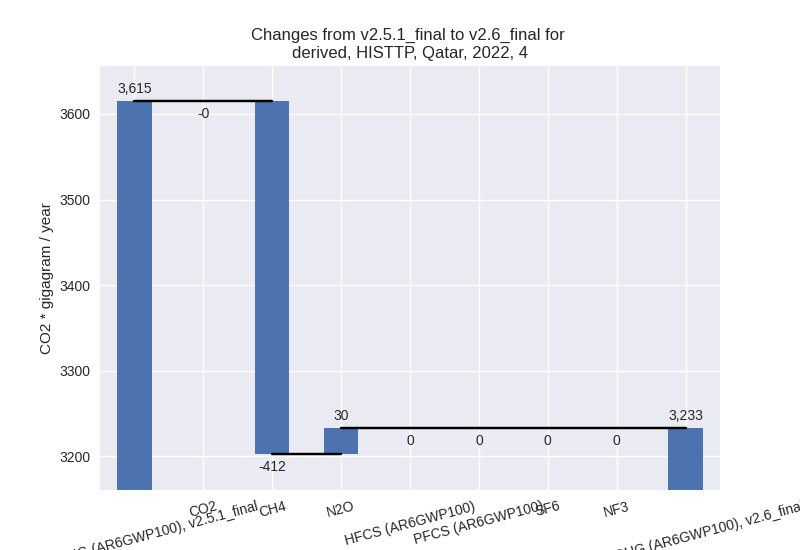
- 5: Total sectoral emissions in 2022 are 284.34 Gg
CO2 / year which is 0.1% of M.0.EL emissions. 2022 Emissions have
changed by -3.5% (-10.42 Gg CO2 /
year). 1990-2022 Emissions have changed by -0.5% (-0.73 Gg CO2 / year). For 2022 the
changes per gas
are:
